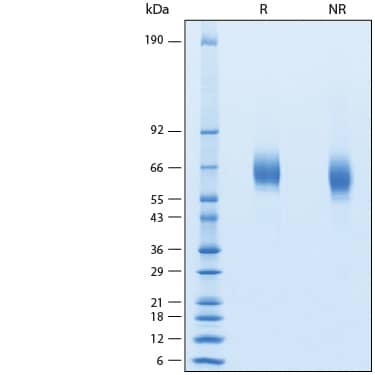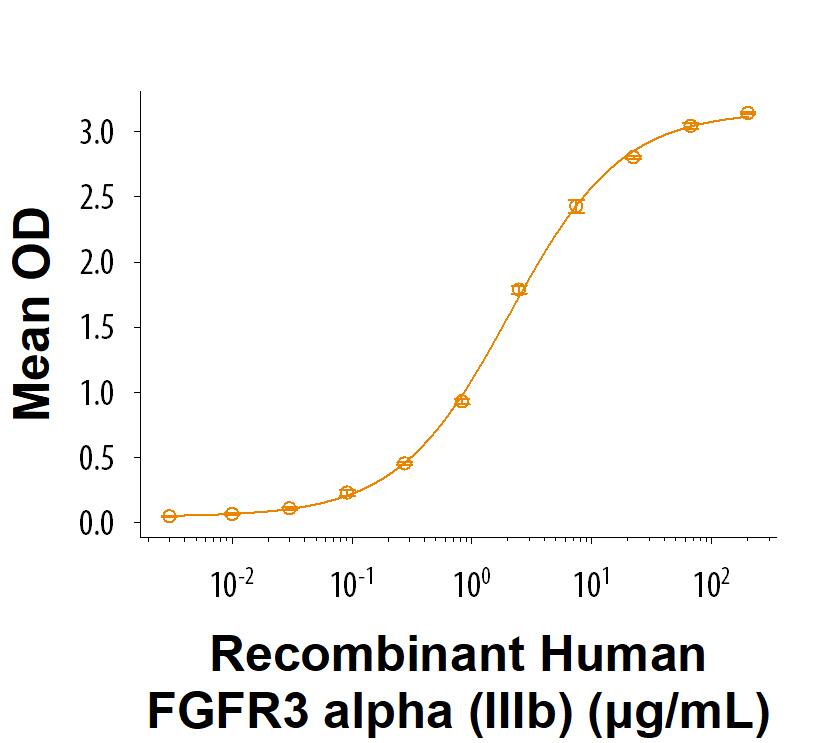Recombinant Human FGFR3 alpha (IIIb) His-tag Protein, CF
R&D Systems, part of Bio-Techne | Catalog # 11136-FR

Key Product Details
- R&D Systems CHO-derived Recombinant Human FGFR3 alpha (IIIb) His-tag Protein (11136-FR)
- Quality control testing to verify active proteins with lot specific assays by in-house scientists
- All R&D Systems proteins are covered with a 100% guarantee
Product Specifications
Source
Chinese Hamster Ovary cell line, CHO-derived human FGFR3 protein
Glu23-Gly377, with a C-terminal 6-His tag
Glu23-Gly377, with a C-terminal 6-His tag
Purity
>95%, by SDS-PAGE visualized with Silver Staining and quantitative densitometry by Coomassie® Blue Staining.
Endotoxin Level
<0.10 EU per 1 μg of the protein by the LAL method.
N-terminal Sequence Analysis
Glu23
Predicted Molecular Mass
39 kDa
SDS-PAGE
60-66 kDa, under reducing conditions.
Activity
Measured by its binding ability in a functional ELISA.
Recombinant Human FGFR3 alpha (IIIb) His-tag (Catalog # 11136-FR) binds to Recombinant Human FGF acidic/FGF1 (aa 16-155) Protein (Catalog # 232-FA) with an ED50 of 0.700-7.00 μg/mL.
Recombinant Human FGFR3 alpha (IIIb) His-tag (Catalog # 11136-FR) binds to Recombinant Human FGF acidic/FGF1 (aa 16-155) Protein (Catalog # 232-FA) with an ED50 of 0.700-7.00 μg/mL.
Scientific Data Images for Recombinant Human FGFR3 alpha (IIIb) His-tag Protein, CF
Recombinant Human FGFR3 alpha (IIIb) His-tag Protein Binding Activity.
Measured by its binding ability in a functional ELISA. Recombinant Human FGFR3 alpha (IIIb) His-tag Protein (Catalog # 11136-FR) binds to Recombinant Human FGF acidic/FGF1 (aa 16-155) Protein (232-FA) with an ED50 of 0.700-7.00 μg/mL.Recombinant Human FGFR3 alpha (IIIb) His-tag Protein SDS-PAGE.
2 μg/lane of Recombinant Human FGFR3 alpha (IIIb) His-tag Protein (Catalog # 11136-FR) was resolved with SDS-PAGE under reducing (R) and non-reducing (NR) conditions and visualized by Coomassie® Blue staining, showing bands at 60-66 kDa.Formulation, Preparation and Storage
11136-FR
| Formulation | Lyophilized from a 0.2 μm filtered solution in PBS with Trehalose. |
| Reconstitution | Reconstitute at 500 μg/mL in PBS. |
| Shipping | The product is shipped at ambient temperature. Upon receipt, store it immediately at the temperature recommended below. |
| Stability & Storage | Use a manual defrost freezer and avoid repeated freeze-thaw cycles.
|
Background: FGFR3
References
- Ornitz, D.M. and Itoh, N. (2015) Wiley Interdiscip Rev Dev Biol. 4:215.
- Zhang, X. et al. (2006) J Biol Chem. 281:15694.
- Ferguson, H.R. et al. (2021) Signaling. Cells 10:1201.
- Holzmann, K. et al. (2012) J Nucleic Acids. 2012:950508.
- Xie, Y. et al. (2020) Sig Transduct Target Ther 5:181.
- Mossahebi-Mohammadi, M. et al. (2020) Front Cell Dev Biol. 18:79.
- Sturla, L.M. et al. (2003) Br. J. Cancer 89:1276.
- Paur, J. et al. (2015) Hepatology. 62:1767.
- Teven, C.M. et al. (2014) Genes Dis. 1:199.
Long Name
Fibroblast Growth Factor Receptor 3
Alternate Names
CD333, CEK, FGF R3, JTK4
Gene Symbol
FGFR3
UniProt
Additional FGFR3 Products
Product Documents for Recombinant Human FGFR3 alpha (IIIb) His-tag Protein, CF
Product Specific Notices for Recombinant Human FGFR3 alpha (IIIb) His-tag Protein, CF
For research use only
